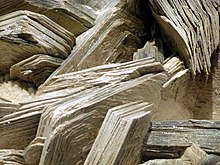
The Irish defective block crisis affects several counties within the Republic of Ireland. To date the counties most severely impacted have been County Donegal and County Mayo, with other counties having fewer affected buildings. An expert committee established in 2016 by the then Minister of Housing and Urban Renewal investigated the causes in both County Donegal and County Mayo, and concluded that the principal cause of the damage was due to the use of defective concrete blocks.[1] Within county Donegal this was originally termed the Mica scandal in 2011, which is the point at which homes and other buildings began showing signs of cracking and decay.[2] The term "mica scandal" arose because the expert committee had observed that defective concrete blocks within County Donegal contained excessive quantities of the mineral mica liberated within the binder. Within County Mayo the expert committee concluded that the defective blocks were caused by internal sulphate attack sourced from framboidal pyrite within the aggregate, as evidenced from both presence of framboidal pyrite and elevated sulphate content.[1]
The scandal led to calls for, and then the establishment of, a scheme to fund affected homeowners of the fault to repair, or demolish and rebuild, their homes.[2] A similar issue with the presence of pyrite in the hardfill of properties was also identified in 2007, originating within quarries in the east of Ireland,[3] and legislation was enacted to address both of the issues similarly. During 2023, new theories were advanced as to the source of the problems with the blocks, specifically that within County Donegal elevated concentrations of pyrrhotite (above relevant EN 12620 guidance[4]) was the principal cause of the problem, albeit with the elevated mica contributing to a weakened binder.[5][6] At present the root cause in County Mayo and other counties is considered to be the presence of framboidal pyrite as highlighted by the original expert report.
- ^ a b Report of the expert panel on concrete blocks. Department of housing, local government and heritage. June 2017. p. https://assets.gov.ie/41388/962cea6b9fdb467498d3b790ad1b3b62.pdf.
- ^ a b Hennessy, Michelle (15 June 2021). "The Mica controversy explained: Here's why thousands of people took to the streets of Dublin to protest today". TheJournal.ie. Retrieved 27 January 2022.
- ^ Pyrite Panel (2012). Report of the pyrite panel. Department of housing, local government and heritage.
- ^ Guidance on the use of I.S. EN12620:2002+A1:2008 - Aggregates for concrete. National standards authority of Ireland. 2016.
- ^ Andreas Leemann; Barbara Lothenbach; Beat Münch; Thomas Campbell; Paul Dunlop (June 2023). "The 'mica crisis' in Donegal - A case of internal sulfate attack?"". Cement and Concrete Research. 168 107149. doi:10.1016/j.cemconres.2023.107149.
Apart from mica, the aggregates contain iron sulphides mainly in the form of pyrrhotite. The sulfur content of the aggregates considerably exceeds the limit value defined by the European standard for concrete aggregates (EN 12620). The results of the microstructural analysis coupled with thermodynamic modelling demonstrate that the concrete suffers from internal sulfate attack triggered by pyrrhotite oxidation.
- ^ Brough, C.; Staniforth, B.; Garner, C.; Garside, R.; Colville, R.; Strongman, J.; Fletcher, J. (8 December 2023). "High risk concrete blocks from County Donegal: The geology of defective aggregate and the wider implications". Construction and Building Materials. 408: 133404. doi:10.1016/j.conbuildmat.2023.133404. ISSN 0950-0618.
...tested concrete block samples from over 1800 properties in County Donegal and observed deterioration patterns based on the aggregate types used ... more than 25 aggregate types have been used within concrete block, with seven distinct types considered high risk ... elevated free mica and elevated reactive sulphides (predominantly pyrrhotite) contents appear to play a critical role ... The particular concentration of both of these mineral groups is considered the main cause of the rapid degradation ...